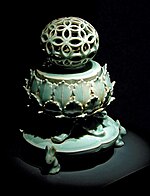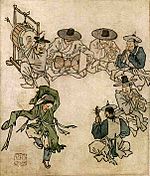National Museum of Korea
Since its establishment in 1945,[2] the museum has been committed to various studies and research activities in the fields of archaeology, history, and art, continuously developing a variety of exhibitions and education programs.
In December 1996, the museum was opened to the public in temporary accommodations in the renovated Social Education Hall, before officially reopening in its new building in Yongsan Family Park on October 28, 2005.
[4] The museum is situated on what used to be a golf course that was part of the Yongsan Garrison, the central command of the United States Forces stationed in Korea.
[5] In order to protect the artifacts inside the museum, the main building was built to withstand a magnitude 6.0 Richter Scale earthquake.
The ground floor contains parks; gardens of indigenous plants; waterfalls and pools; and a collection of pagodas, stupas, lanterns, and steles (including National Treasure of Korea No.
On the first floor is the Prehistory and Ancient History Gallery, which contains approximately 4,500 artifacts from the Paleolithic to the Unified Silla era excavated from sites across Korea.
Ranging from chipped stone handaxes to luxurious ancient royal ornaments, the relics displayed here show the long journey taken by early settlers on the Peninsula towards developing their unique culture.
Artifacts from important prehistoric sites and settlements such the Bangudae Petroglyphs and Songgung-ni are found in the Neolithic and Bronze Age Rooms.
Also on the first floor is the Medieval and Early Modern History Gallery, which showcases the cultural and historical heritage throughout the Unified Silla, Balhae, Goryeo, and Joseon periods.
There are remarkable similarities with the wooden Pensive Bodhisattva at the Koryuji Temple in Kyoto, Japan, which is believed to have been founded by a Silla monk.
In 1907, it was illegally smuggled to Japan by a Japanese court official, but was returned in 1918 at the behest of British and American journalists, E. Bethell and H. Hulbert.
[6] Gyujanggak was a royal library established on the grounds of Changdeokgung Palace in the capital by order of King Jeongjo, the 22nd ruler of the Joseon, in 1776.
Their historical and cultural value has been recognized globally, as the "Royal Protocols of Joseon Dynasty"* were inscribed into the UNESCO Memory of the World Register in 2007.
During the Korea-France summit in September 1993, French President François Mitterrand, aiming to secure the TGV contract for the construction of the Gyeongbu high-speed railway, brought one volume of the "Huigyeongwonweonsodogam Uigwe" to demonstrate his intention to return the Oegyujanggak books.
[10] In October 2000, at another summit between the two countries, they agreed to return 63 volumes, which had no handwritten copies in Korea, in the form of a "reciprocal cultural heritage exchange exhibition" by 2001.
[11] Additionally, within Korea, historical, academic, and civic organizations were expanding their movement for the return of the Oegyujanggak books, insisting on unconditional repatriation, even by appealing to the International Court of Justice.
[14][15]A special exhibition, The Return of the Oegyujanggak Uigwe from France: Records of the State Rites of the Joseon Dynasty, was held from 19 July to 18 September 2011.






